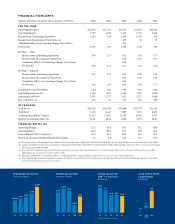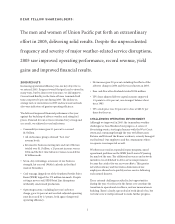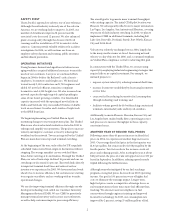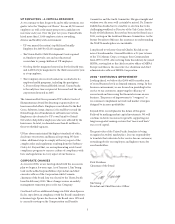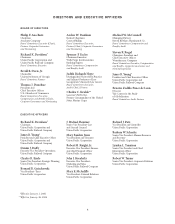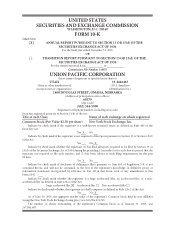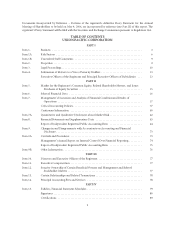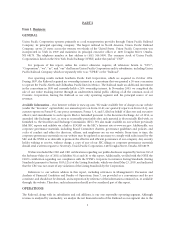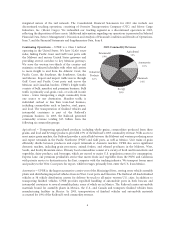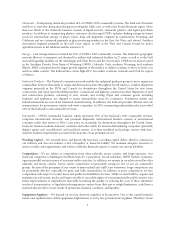Union Pacific 2005 Annual Report Download - page 3
Download and view the complete annual report
Please find page 3 of the 2005 Union Pacific annual report below. You can navigate through the pages in the report by either clicking on the pages listed below, or by using the keyword search tool below to find specific information within the annual report.2005 RESULTS
Increasing operational eciency was our key objective as
we entered 2005. Progress toward that goal can be viewed in
many ways, but by almost every measure, we did improve.
Our network uidity, in the form of lower terminal dwell
times, improved 6 percent during 2005. e decline in
average rail car inventories in 2005 and increased carloads
also were indicators of greater operating eciency.
We delivered improved nancial performance this year
against the backdrop of adverse weather and rising fuel
prices. Demand for our services remained very strong and,
as a result, we achieved several milestones:
• Commodity revenue grew 11 percent to a record
$13 billion.
n All six business groups attained “best ever”
revenue levels.
n Revenue for business moving into and out of Mexico
totaled over $1.1 billion, a 15 percent increase versus
2004 and the rst time Mexico revenue exceeded the
$1 billion mark.
• Seven-day carloadings, a measure of our business
strength, hit a record 198,416 carloads in the third
week of November.
• Coal tonnage shipped out of the Southern Powder River
Basin (SPRB) topped the 179 million ton mark. Despite
setting a new record, SPRB Joint Line disruptions
articially constrained production.
• Operating income, excluding last year’s asbestos
charge, grew 16 percent and our fuel-adjusted operating
ratio decreased by 1.5 points, both signs of improved
operating eciency.
• Net income grew 20 percent excluding the eects of the
asbestos charge in 2004 and the tax reduction in 2005.
• Free cash ow aer dividends totaled $234 million.
• UP’s lease adjusted debt to capital measure improved
1.5 points to 43.6 percent, our strongest balance sheet
since 1985.
• UP’s stock price rose 20 percent to close at $80.51 per
share for the year.
CHALLENGING OPERATING ENVIRONMENT
Although we improved in 2005, the tremendous weather
challenges we faced hindered our progress. A series of
devastating events, starting in January with the West Coast
storm and continuing through the year with Hurricanes
Katrina and Rita and the Kansas washouts, severely damaged
our Railroad. Our employees and the communities where
we operate were impacted as well.
Weather issues and an expanded repair program caused
operational problems on the SPRB Joint Line in Wyoming
for much of the year. e additional resources and network
initiatives we established to drive service improvement
became the catalyst for our recovery eorts. is greater
network resiliency and the tireless dedication of our
employees allowed us to quickly restore service following
each natural disaster.
ese external challenges resulted in lost opportunities
during the year. Our focus for the future is to continue the
transition to operational excellence, and our momentum is
building. ere’s clearly a great deal of work ahead of us, but
we believe we’re well positioned to make further progress.
1
D E A R F E L LO W SH A R E H O LD E R S :
The men and women of Union Pacific put forth an extraordinary
effort in 2005, delivering solid results. Despite the unprecedented
frequency and severity of major weather-related service disruptions,
2005 saw improved operating performance, record revenue, yield
gains and improved financial results.


